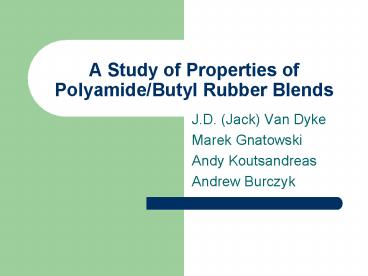A Study of Properties of PolyamideButyl Rubber Blends - PowerPoint PPT Presentation
1 / 16
Title:
A Study of Properties of PolyamideButyl Rubber Blends
Description:
A Study of Properties of Polyamide/Butyl Rubber Blends. J.D. (Jack) Van Dyke. Marek Gnatowski ... Graft/block formation during high speed mixing. Halogenated ... – PowerPoint PPT presentation
Number of Views:184
Avg rating:3.0/5.0
Title: A Study of Properties of PolyamideButyl Rubber Blends
1
A Study of Properties of Polyamide/Butyl Rubber
Blends
- J.D. (Jack) Van Dyke
- Marek Gnatowski
- Andy Koutsandreas
- Andrew Burczyk
2
Blending Possibilities
- Type of butyl rubber (IIR, CIIR, BIIR)
- Proportion in the blend
- Non-vulcanized or dynamically vulcanized
- Vulcanizing agent (S, ZnO/ZDEDC, MgO/ Amine)
- Type of polyamide
- Blending conditions
- Preparation of the sample
3
Polyamide/Butyl Rubber Blends Non-Vulcanized
- Halogenated butyl rubber - more reactive
- Graft/block formation during high speed mixing
- Halogenated butyl rubber more graft/block
- Evidence of graft/block in extracted samples
- Presence of polyamide peak by FTIR
- Microanalysis indicates excess nitrogen present
4
Tensile Properties of Polyamide 12/ Rubber Blends
- Non-Vulcanized
5
Non-Vulcanization vs. Dynamic Vulcanization
6
Dynamic Vulcanization
7
Rheology of PA/Butyl Rubber Blends Comparison
8
Insolubles Non Vulcanized vs. Dynamically
Vulcanized
9
Polyamide Melting Temperature - Effect of Rubber
Type and Processing
10
Comparison of Tensile Strengths - Non-Vulcanized
and Dynamically Vulcanized
11
Comparison of Elongations - Non-Vulcanized and
Dynamically Vulcanized
12
Effect Molding Procedure on Tensile Properties
for Dynamically-Vulcanized 40/60 PA/Rubber Blends
13
Effect of Rubber Properties on Tensile Strength
for Dynamically Vulcanized 40/60 PA/Rubber Blends
14
Conclusions
- Compatible blends are formed under high shear
mixing - both non-vulcanized and vulcanized. - Rheology of the blends depends on the method of
preparation. - A sample is more processible at high shear in
dynamically vulcanized blends.
15
Conclusions
- 4. For dynamically vulcanized blends, the
highest tensile and elongation values are
obtained with CIIR as the blend component. - 5. Mechanical properties seem to be affected by
- a. type of halogen
- b. Mooney viscosity of the rubber
- c. method of processing
- d. not affected by the unsaturation in the
rubber phase.
16
Acknowledgements
- Department of National Defence Canada
- Laboratory staff at PEC
- Dave Lesewick, Christine Mah
- Laboratory staff at TWU
- Andria Lengkeek, Miriam Buschhaus
- Polymer Engineering Co. and Trinity Western
University - Generous use of facilities































